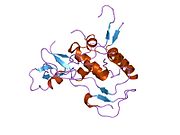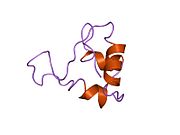Insulin-like growth factor 1
Ensembl | |||||||||
|---|---|---|---|---|---|---|---|---|---|
| UniProt | |||||||||
| RefSeq (mRNA) |
| ||||||||
| RefSeq (protein) | |||||||||
| Location (UCSC) | Chr 12: 102.4 – 102.48 Mb | Chr 10: 87.69 – 87.77 Mb | |||||||
| PubMed search | [3] | [4] | |||||||
| View/Edit Human | View/Edit Mouse |
Insulin-like growth factor 1 (IGF-1), also called somatomedin C, is a
In the 1950s IGF-1 was called "sulfation factor" because it stimulated sulfation of cartilage in vitro,[6] and in the 1970s due to its effects it was termed "nonsuppressible insulin-like activity" (NSILA).[7]
IGF-1 is a protein that in humans is encoded by the IGF1 gene.[8][9] IGF-1 consists of 70 amino acids in a single chain with three intramolecular disulfide bridges. IGF-1 has a molecular weight of 7,649 daltons.[10] In dogs, an ancient mutation in IGF1 is the primary cause of the toy phenotype.[11]
IGF-1 is produced primarily by the liver. Production is stimulated by growth hormone (GH). Most of IGF-1 is bound to one of 6 binding proteins (IGF-BP). IGFBP-1 is regulated by insulin. IGF-1 is produced throughout life; the highest rates of IGF-1 production occur during the pubertal growth spurt.[12] The lowest levels occur in infancy and old age.[13][14]
A synthetic analog of IGF-1,
Cyclic glycine-proline (cGP) is a metabolite of hormone insulin-like growth factor-1 (IGF-1). It has a cyclic structure, lipophilic nature, and is enzymatically stable which makes it a more favourable candidate for manipulating the binding-release process between IGF-1 and its binding protein, thereby normalising IGF-1 function.[16]
Synthesis and circulation
The
A deficiency of IGF-1 is associated with the increased risks of
The levels of IGF-1 in the body vary throughout life, depending on age, where peaks of the hormone is generally observed during puberty and the

Mechanism of action
IGF-1 is a primary mediator of the effects of
IGF-1 binds to at least two cell surface
IGF-1 binds and activates its own receptor, IGF-1R, through the cell surface expression of Receptor Tyrosine Kinase's (RTK's), and further signals through multiple intracellular transduction cascades. IGF-1R is the critical role-playing inducer in modulating the metabolic effects of IGF-1 for cellular senescence and survival. At a localized target cell, IGF-1R elicits the mediation of paracrine activity. After its activation the initiation of intracellular signaling occurs inducing a magnitude of signaling pathways. An important mechanistic pathway involved in mediating a cascade affect regulated by phosphatidylinositol-3 kinase (PI3K) and its downstream partner, mTOR (mammalian Target of Rapamycin). Rapamycin binds with the enzyme FKBPP12 to inhibit the mTORC1 complex. mTORC2 remains unaffected and responds by up-regulating AKT, driving signals through the inhibited mTORC1. Phosphorylation of Eukaryotic translation initiation factor 4E (EIF4E) by mTOR suppresses the capacity of Eukaryotic translation initiation factor 4E-binding protein 1 (EIF4EBP1) to inhibit EIF4E and slow metabolism.[25][26] A mutation in the signaling pathway PI3K-AKT-mTOR is a big factor in the formation of tumors found predominantly on skin, internal organs, and secondary lymph nodes (Kaposi sarcoma).[26]
Metabolic effects
As a major growth factor, IGF-1 is responsible for stimulating growth of all cell types, and causing significant metabolic effects.[27] One important metabolic effect of IGF-1 is its ability to signal cells that sufficient nutrients are available for cells to undergo hypertrophy and cell division.[28] These signals also enable IGF-1 to inhibit cell apoptosis and increase the production of cellular proteins.[28] IGF-1 receptors are ubiquitous, which allows for metabolic changes caused by IGF-1 to occur in all cell types.[27] IGF-1's metabolic effects are far-reaching and can coordinate protein, carbohydrate, and fat metabolism in a variety of different cell types.[27] The regulation of IGF-1's metabolic effects on target tissues is also coordinated with other hormones such as growth hormone and insulin.[29]
Related growth factors
IGF-1 exists within the insulin/insulin-like growth factor (IGF) signaling system. The system consists of three ligands (
Similarly to IGF-1,
A
Disorders
Laron syndrome
Patients with severe primary insulin-like growth factor-1 deficiency (IGFD), called
Laron syndrome does not respond at all to
People with Laron syndrome have very low rates of both cancer and diabetes.[37]
Acromegaly
High level of IGF-1 in acromegaly is related to an increased risk of some cancers, particularly colon cancer and thyroid cancer.[39]
Use as a diagnostic test
This section needs more primary sources. (December 2019) |  |
IGF-1 levels can be analyzed and used by physicians as a
The ratio of IGF-1 and insulin-like growth factor 1 binding protein-3 (IGFBP-3) can be analyzed and used as a diagnostic tool for growth-hormone related disorders.[41]
Interpretation of IGF-1 levels is complicated by the wide normal ranges, and marked variations by age, sex, and pubertal stage. Clinically significant conditions and changes may be masked by the wide normal ranges. Sequential measurement over time is often useful for the management of several types of pituitary disease, undernutrition, and growth problems.[42]
Causes of elevated IGF-1 levels
- acromegaly (especially when GH is also high)[38]
- high-protein diet[43]
- dairy products (except for cheese) consumption[44]
- delayed puberty[45]
- pregnancy[46]
- hyperthyroidism[46]
- IGF-1 assay problems[46]
- some rare tumors (i.e. carcinoids) secreting IGF-1[47]
Health effects
Cancer
Several studies have shown associations between high levels of IGF-1 and an increased risk of tumor development. With an increase in serum IGF-1 levels of 100 ng/ml, there was a corresponding increase in the risk of colorectal cancer with 69%. High levels of IGF-1 were also associated with a 65% risk increase in breast cancer, 49% increase in prostate cancer and 106% in lung cancer.[48]
It has been suggested that consumption of IGF-1 in dairy products could increase cancer risk, particularly prostate cancer.[49][50] However, a 2018 review by the Committee on Carcinogenicity of Chemicals in Food, Consumer Products and the Environment (COC) concluded that there is "insufficient evidence to draw any firm conclusions as to whether exposure to dietary IGF-1 is associated with an increased incidence of cancer in consumers".[50] Certain dairy processes such as fermentation are known to significantly decrease IGF-1 concentrations.[51]
A mutation in the signaling pathway PI3K-AKT-mTOR is a factor in the formation of tumors found predominantly on skin, internal organs, and secondary lymph nodes (Kaposi sarcoma).[52]
Diabetes
Low IGF-1 levels are shown to increase the risk of developing type 2 diabetes and insulin resistance.[53] On the other hand, a high IGF-1 bioavailability in diabetes patients may delay or prevent the inception of diabetes-associated complications. A normal functioning IGF-1 mechanism reduces the occurrence of diabetes complications associated with lower IGF-1 levels, as it improves impaired small blood vessel function.[54]
Mortality
A 2022 review found that both high and low levels of IGF‐1 increase mortality risk, whilst a mid‐range (120–160 ng/ml) is associated with the lowest mortality.[48]
Other
Increased IGF-1 levels are associated with a lower risk of
Clinical trials
Mecasermin
Mecasermin is a complex consisting of recombinant human IGF-1 and recombinant human IGF-binding protein-3.[58] The complex is used for the long-term treatment in children with growth failure, where they suffer from severe IGF-1 deficiency unresponsive to GH. Children with growth failure were given 0,12 mg/kg subcutaneous mecasermin two times a day over a period with a mean duration of 4,4 years (range: 0,04-12,5 years). During the first year of treatment the height velocity of the children increased from a mean of 2,8 cm/year at baseline to a mean of 8,0 cm/year. The mean growth velocities continued to remain above baseline for up to 8 years.[59]
Mecasermin therapy is also shown to be beneficial with other conditions including diabetes mellitus and anorexia nervosa.[59]
rhIGF-1
Several companies have evaluated administering recombinant human IGF-1 (rhIGF-1) in clinical trials for type 1 diabetes. These patients, despite having increased GH secretion, have low levels of circulating IGF-1 and therefore may benefit from rhIGF-1 therapy.[60] Results shows that a rhIGF-1 therapy two times a day in adults with type 1 diabetes increased the circulating IGF-1. This was with a reciprocal decrease in IGF-2 and an elevation of IGFBP-2.[60]
See also
References
- ^ a b c GRCh38: Ensembl release 89: ENSG00000017427 – Ensembl, May 2017
- ^ a b c GRCm38: Ensembl release 89: ENSMUSG00000020053 – Ensembl, May 2017
- ^ "Human PubMed Reference:". National Center for Biotechnology Information, U.S. National Library of Medicine.
- ^ "Mouse PubMed Reference:". National Center for Biotechnology Information, U.S. National Library of Medicine.
- PMID 23382729.
- PMID 13429201.
- PMID 640301.
- S2CID 5825276.
- S2CID 4336584.
- PMID 632300.
- S2CID 246359754.
- PMID 28076448.
- S2CID 6965802.
- S2CID 24346368.
- PMID 18481900.
- PMID 36770687.
- ^ PMID 32548700.
- ^ ISSN 1018-3647.
- ^ S2CID 163168020.
- PMID 24606898.
- PMID 12235108.
- PMID 10490655.
- PMID 10364155.
- S2CID 14265087.
- PMID 23708663.
- ^ PMID 30894372.
- ^ PMID 22682639.
- ^ PMID 26453498.
- PMID 14702105.
- PMID 34680948.
- S2CID 24843614.
- ISBN 978-0-12-370879-3.
GF-II appears to be essential for normal embryonic development and, as such, IGF-II is thought to be a fetal growth factor. IGF-II is highly expressed in embryonic and neonatal tissues and promotes proliferation of many cell types primarily of fetal origin.
- PMID 17581790.
- S2CID 23165648.
- ^ PMID 25470569.
- PMID 24639006.
- PMID 21325617.
- ^ PMID 24566817.
- PMID 30197531.
- PMID 34373538.
- PMID 36251796.
- PMID 38044875.
- PMID 24606898.
- PMID 21699736.
- PMID 20862389.
- ^ PMID 19226264.
- PMID 19766843.
- ^ PMID 35048526.
- PMID 28361446.
- ^ a b "Statement on possible carcinogenic hazard to consumers from insulin-like growth factor-1 (IGF-1) in the diet" (PDF). assets.publishing.service.gov.uk. Retrieved 4 February 2023.
- PMID 28544872.
- PMID 30894372.
- PMID 33905470.
- PMID 33905470.
- PMID 30735831.
- S2CID 248924624.
- PMID 35705353.
- S2CID 262107214.
Mecasermin is a complex of recombinant human IGF-1 and recombinant human IGF-binding protein-3 (rhIGFBP-3) used to treat children with severe IGF-1 deficiency unresponsive to GH.
- ^ PMID 18481900.
- ^ S2CID 20727527.
External links
- Insulin-Like+Growth+Factor+I at the U.S. National Library of Medicine Medical Subject Headings (MeSH)
- Overview of all the structural information available in the PDB for UniProt: P05019 (Insulin-like growth factor I) at the PDBe-KB.















![3lri: Solution structure and backbone dynamics of long-[Arg(3)]insulin-like growth factor-I](http://upload.wikimedia.org/wikipedia/commons/thumb/3/3b/PDB_3lri_EBI.jpg/180px-PDB_3lri_EBI.jpg)